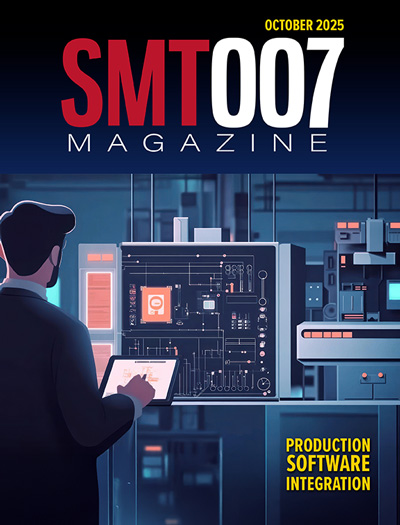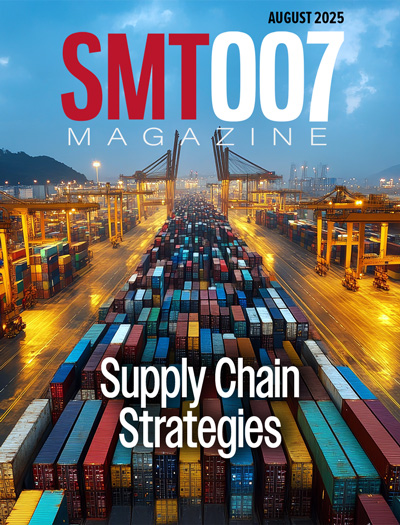-

- News
- Books
Featured Books
- smt007 Magazine
Latest Issues
Current Issue
Production Software Integration
EMS companies need advanced software systems to thrive and compete. But these systems require significant effort to integrate and deploy. What is the reality, and how can we make it easier for everyone?

Spotlight on India
We invite you on a virtual tour of India’s thriving ecosystem, guided by the Global Electronics Association’s India office staff, who share their insights into the region’s growth and opportunities.

Supply Chain Strategies
A successful brand is built on strong customer relationships—anchored by a well-orchestrated supply chain at its core. This month, we look at how managing your supply chain directly influences customer perception.
- Articles
- Columns
- Links
- Media kit
||| MENU - smt007 Magazine
Happy New Year From I-Connect007
January 1, 2025 | Nolan Johnson, I-Connect007Estimated reading time: 1 minute
As I-Connect007 observes the New Year’s Day holiday, we also wish you and yours a prosperous new year. We will be back covering the news of the industry tomorrow, January 2, 2025, according to the Gregorian calendar. Why do we follow the Gregorian format anyway?
Over the past two millennia, Western civilization has relied upon two similar but different calendars: the Gregorian and the Julian. Julius Caesar introduced the Julian calendar in 46 BC. The Julian calendar was ultimately replaced by the Gregorian calendar in 1582 when Pope Gregory XIII introduced it in an effort to keep the calendar more closely aligned with the seasons.
Both calendars feature 12 months and 365 days, but they differ in how they calculate leap years. For example, the Julian calendar adds a leap day every four years. The Gregorian calendar, in an effort to be more accurate, omits the leap day on century years which are not exactly divisible by four.
Complicated? A little. But the result is that the Gregorian calendar is a few minutes shorter than the Julian calendar. The average length of a Gregorian calendar year is 365 days, 5 hours, 49 minutes, and 20 seconds, which is only 34 seconds longer than the actual year. Interestingly, the U.S. military uses the Julian calendar to track inventory, and Julian dates are often used as time variables in astronomical software.
Our team hopes you all have a fantastic new year!
Testimonial
"Our marketing partnership with I-Connect007 is already delivering. Just a day after our press release went live, we received a direct inquiry about our updated products!"
Rachael Temple - AlltematedSuggested Items
AI Triggers Next Paradigm Shift in PDN
10/23/2025 | Istvan Novak, SamtecArtificial intelligence (AI), together with machine learning (ML), is creating an unprecedented surge of computing and networking infrastructure needs. This, in turn, has dramatically increased the power consumption of computing and networking chips.
Teledyne FLIR Defense to Deliver Portable Chemical Detectors to US Customs and Border Protection
10/21/2025 | BUSINESS WIRETeledyne FLIR Defense, part of Teledyne Technologies Incorporated, announced that it has received an order from U.S. Customs and Border Protection (CBP) for 15 of its Griffin™ G510x portable chemical detectors, specifically designed to analyze and identify explosives and narcotics, such as fentanyl and nitazenes, within five minutes.
Curtiss-Wright to Supply Turret Drive Stabilization Systems for U.S. Army XM30 Combat Vehicle Prototypes
10/16/2025 | BUSINESS WIRECurtiss-Wright Corporation announced that it has been selected by American Rheinmetall to provide its Turret Drive Stabilization System (TDSS) for the prototype phase of the U.S. Army’s XM30 Combat Vehicle (CV) program, which was recently approved to advance to Milestone B, the Engineering and Manufacturing Development (EMD) phase.
Episode 6 of Ultra HDI Podcast Series Explores Copper-filled Microvias in Advanced PCB Design and Fabrication
10/15/2025 | I-Connect007I-Connect007 has released Episode 6 of its acclaimed On the Line with... American Standard Circuits: Ultra High Density Interconnect (UHDI) podcast series. In this episode, “Copper Filling of Vias,” host Nolan Johnson once again welcomes John Johnson, Director of Quality and Advanced Technology at American Standard Circuits, for a deep dive into the pros and cons of copper plating microvias—from both the fabricator’s and designer’s perspectives.
American Standard Circuits Achieves Successful AS9100 Recertification
10/14/2025 | American Standard CircuitsAmerican Standard Circuits (ASC), a leading manufacturer of advanced printed circuit boards, proudly announces the successful completion of its AS9100 recertification audit. This milestone reaffirms ASC’s ongoing commitment to the highest levels of quality, reliability, and process control required to serve aerospace, defense, space, and other mission-critical industries.


